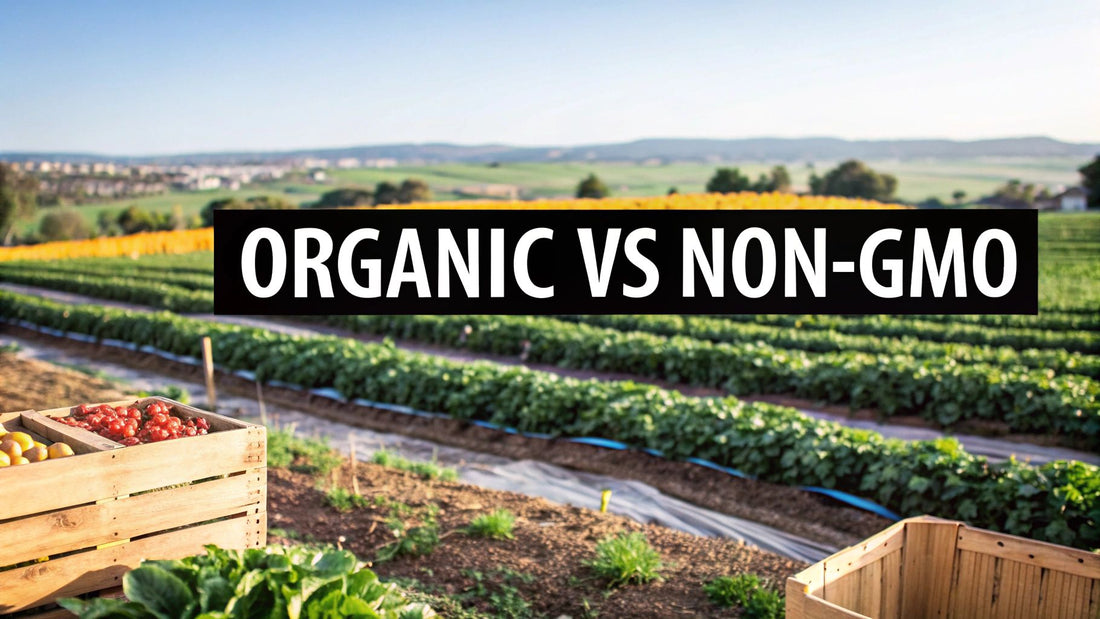
Organic vs Non GMO Choosing What's Right for You
Share
Right off the bat, let's clear up the biggest point in the organic vs. non-GMO conversation. It boils down to a simple, crucial fact: all certified organic food is inherently non-GMO, but the reverse isn't true. Non-GMO food is not automatically organic.
This is because the organic certification is a big-picture deal, covering everything and prohibiting GMOs along with things like synthetic pesticides. The non-GMO label, on the other hand, just focuses on that one piece of the puzzle: ensuring the product is free from genetically modified organisms.
Decoding the Labels: Organic vs Non-GMO
When you're navigating the grocery aisles, that green and white USDA Organic seal and the Non-GMO Project's butterfly logo represent two very different approaches to food quality. Grasping this difference is your first step toward making choices that truly reflect your values for health and the environment.
-
USDA Organic: Think of this as the comprehensive, government-regulated gold standard. It’s a holistic system that scrutinizes the entire production process—from the health of the soil to the welfare of animals. Most importantly, it completely forbids the use of GMOs, synthetic pesticides, and chemical fertilizers.
-
Non-GMO Project Verified: This label comes from a third-party non-profit, and it has a laser focus. It simply verifies that a product and its ingredients have been rigorously tested and are free of genetically modified organisms. It says nothing about whether pesticides were used or what farming methods were employed.
Quick Look Organic vs Non GMO
To make it even clearer, let's put them side-by-side. This table gives you a snapshot of what each label really guarantees.
| Feature | USDA Organic | Non-GMO Project Verified |
|---|---|---|
| GMOs Prohibited | Yes, strictly prohibited | Yes, this is the core focus |
| Synthetic Pesticides | Banned | Permitted |
| Chemical Fertilizers | Banned | Permitted |
| Ingredient Testing | Not typically required | Required for high-risk ingredients |
| Governing Body | U.S. Government (USDA) | Third-Party Nonprofit |
As you can see, "organic" is a much broader, more demanding certification. The non-GMO label is specific and valuable, but it doesn't offer the same wide-ranging assurances.
The demand for this kind of transparency is huge and only getting bigger. The global non-GMO food market, currently valued around $812.5 billion, is expected to more than double by 2032. That's a clear signal that shoppers want to know what's in their food.
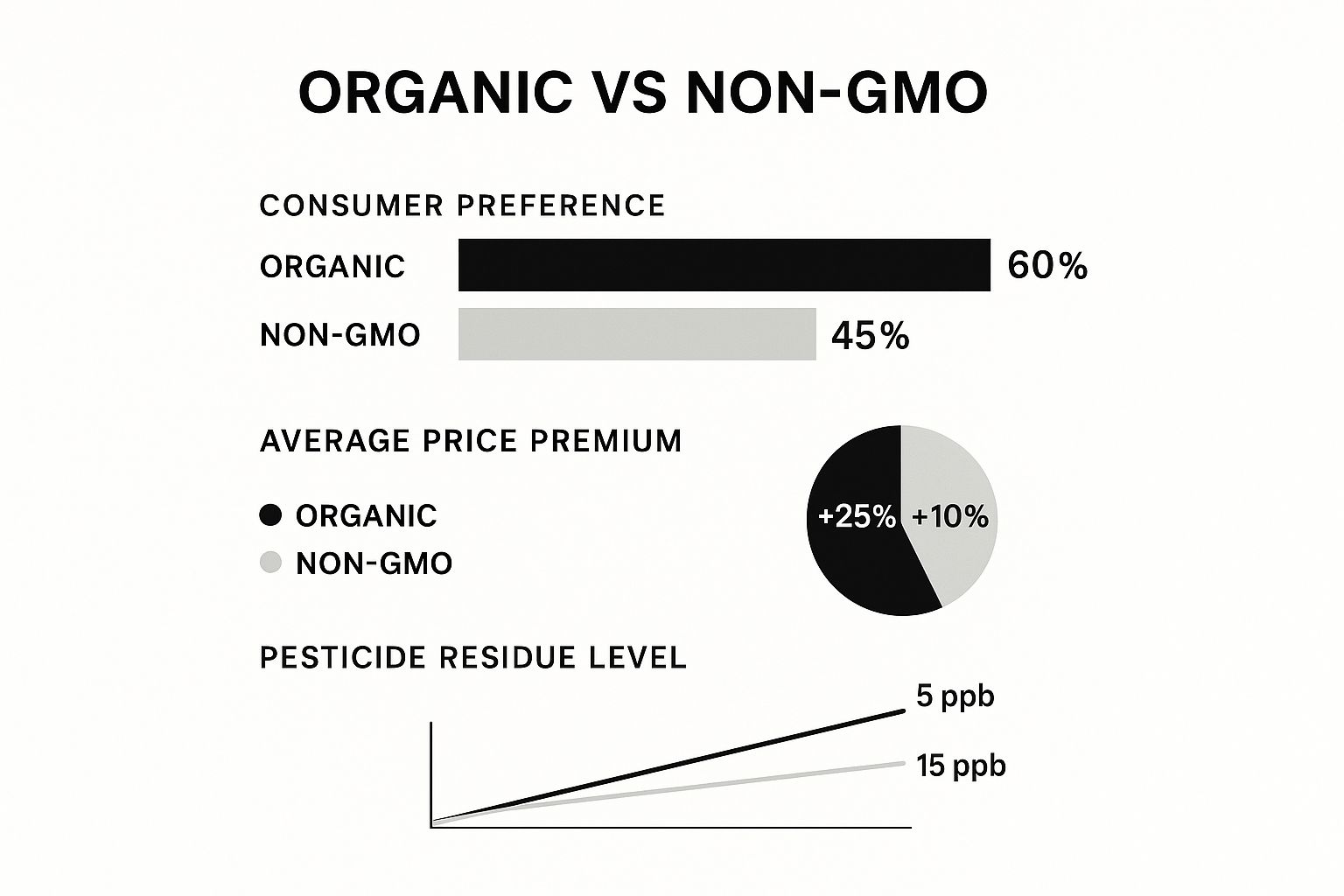
This visual really drives the point home, showing the trade-offs between consumer preference, price, and potential pesticide exposure. While organic consistently wins on preference and has lower pesticide residues, it does come with a higher price tag compared to products that are only certified non-GMO.
For a great real-world example of this single-issue focus, just look at products like non-GMO seeds. The label tells you exactly what you're getting: seeds that haven't been genetically modified. It's a clear, straightforward promise.
Understanding the Certification Process
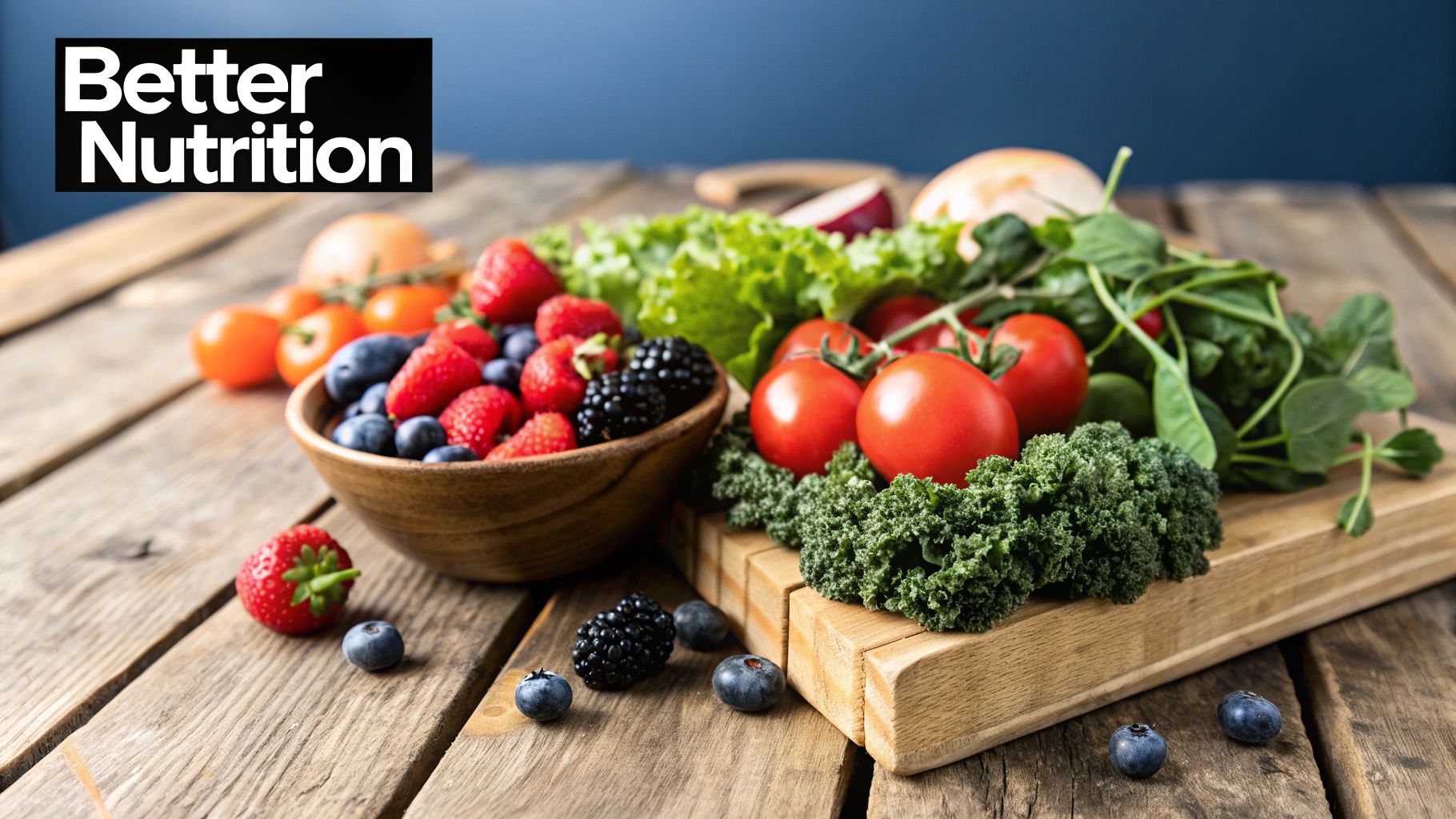
When you see the USDA Organic seal and the Non-GMO Project butterfly on packages, it's easy to assume they're similar. The reality is they represent two fundamentally different journeys to your grocery cart. One is a comprehensive, government-regulated system covering an entire farm, while the other is a private, mission-driven effort focused on verifying a single product. Getting to the heart of the organic vs. non-GMO debate means understanding what it takes to earn each label.
Achieving the USDA Organic seal is a serious, long-term commitment. It isn't as simple as just stopping the use of prohibited chemicals. A farm must first go through a mandatory three-year transition period. For those 36 months, the land has to be managed completely free of synthetic pesticides, fertilizers, and, yes, GMOs.
This process is about building an entire agricultural ecosystem. Farmers have to create a detailed "organic system plan," which is then scrutinized by a third-party certifying agent. This plan is a complete blueprint for their operation, outlining everything from crop rotation and soil management to natural pest control and humane livestock practices. It's a holistic approach to farming.
The Non-GMO Project Verification Approach
The Non-GMO Project, on the other hand, operates quite differently. It isn’t a farm-level certification; it's product-specific. Run by a non-profit organization, its sole focus is to confirm that a finished product doesn't contain genetically modified organisms. As a result, there's no mandatory farm transition period required to get started.
This verification zeroes in on the integrity of the supply chain and its ingredients. For a product to sport the butterfly logo, its "high-risk" ingredients—things like corn, soy, and canola that are frequently genetically modified—must undergo rigorous testing. It’s a laser-focused approach aimed at preventing GMO contamination from the source all the way to the final package.
A key differentiator is the testing protocol. The Non-GMO Project requires testing for major high-risk ingredients to ensure they are below a strict action threshold. In contrast, the USDA Organic program is process-based and doesn't mandate routine GMO testing, relying instead on the approved organic system plan to prevent their use.
How the Processes Differ in Practice
These contrasting paths are why you’ll often find one label on a product but not the other. A company can get a single product Non-GMO Project Verified without overhauling its conventional farming methods, which might still involve synthetic pesticides and fertilizers.
Let's take a granola bar as an example. A manufacturer could source Non-GMO Project Verified oats and corn syrup but use conventionally grown almonds and raisins that were treated with pesticides. The final bar could still earn the butterfly label because its ingredients at high risk for being GMOs were verified.
To get the USDA Organic seal, that same granola bar company would have to source 100% certified organic ingredients—every last one, from the oats to the almonds. This guarantees that every single component was grown under the strict organic standards, making the organic seal a much broader promise about the entire production method.
Comparing Health and Environmental Impacts
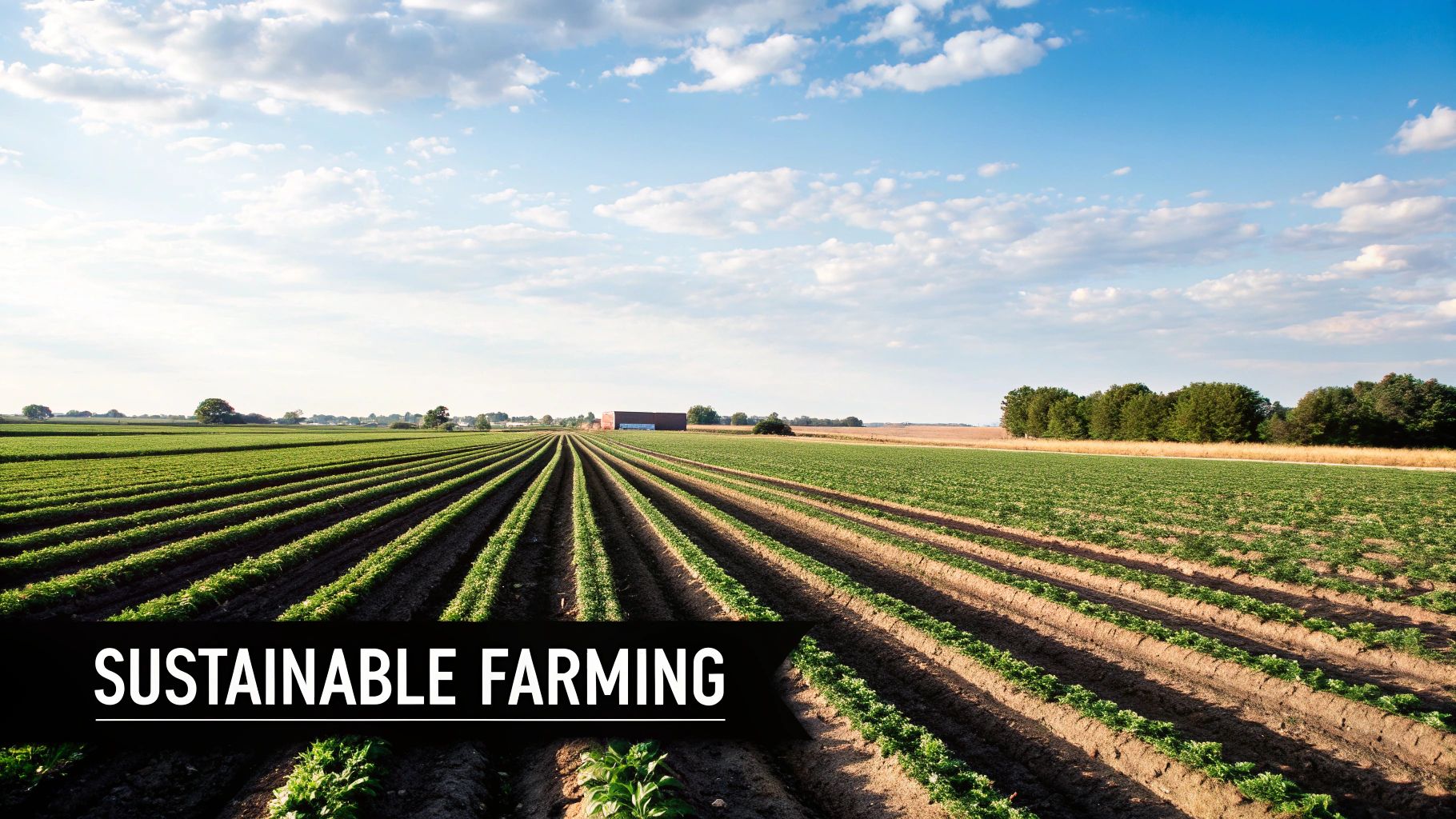
When you're standing in the grocery aisle weighing an organic apple against a non-GMO one, your decision has ripples that extend far beyond your kitchen. You're making a choice that touches on your personal health and the well-being of the environment. The organic vs. non-GMO debate really comes alive when you look at these real-world effects, where the stark differences in farming methods become clear.
The most straightforward health benefit of going organic is simple: you’re dodging a lot of synthetic chemical residues. The USDA Organic seal is a guarantee that hundreds of synthetic pesticides and herbicides were banned from the growing process. By choosing organic, you're actively minimizing your exposure to these substances, which is a top priority for many shoppers.
A non-GMO label, on the other hand, tells you one thing—that the food isn't made with genetically modified ingredients. What it doesn't tell you is how it was grown. It's entirely possible, and actually quite common, for a non-GMO crop to be cultivated using the very same synthetic pesticides and fertilizers found in standard conventional farming.
Examining the Environmental Footprint
This is where the two labels really diverge. The environmental story of organic versus non-GMO is a tale of two completely different approaches to land management, especially when it comes to soil health and biodiversity.
Organic farming is, at its heart, a regenerative system. The goal isn't just to grow food, but to actually improve the land it's grown on.
- Soil Health: Organic standards require practices like crop rotation, composting, and planting cover crops. These aren't just suggestions; they are mandatory methods for building rich, living soil that holds water better and resists erosion.
- Biodiversity: Because synthetic pesticides are off-limits, organic farms become safer spaces for essential pollinators like bees and butterflies. They also support a healthier ecosystem for birds and other wildlife that are crucial for a balanced farm environment.
While avoiding genetic modification is an important goal for non-GMO farming, it doesn't come with the same built-in environmental protections. A farmer can grow non-GMO corn while still relying on methods that deplete the soil and harm local wildlife over the long run.
The core environmental difference is philosophical. Organic farming is designed to actively build a healthier ecosystem as part of its very process. Non-GMO farming focuses on avoiding one specific technology but doesn't mandate broader ecological stewardship.
The Nuances of Nutrition and Consumer Demand
The discussion gets a bit murkier when we talk about nutrition. Some research points to organic produce having higher levels of certain antioxidants, but there isn't a solid scientific consensus that organic food is definitively more nutritious across the board. For now, the clearest health advantage remains the avoidance of synthetic pesticides.
At the same time, the public's appetite for food that feels more natural and transparent is growing fast. The non-GMO food market was valued at USD 947.8 million and is expected to expand at an impressive compound annual rate of 16.5%, with meat and poultry products seeing huge demand. You can explore more about the non-GMO food market trends to see how consumer values are reshaping the industry.
This booming growth shows that shoppers crave transparency, even if a particular label doesn't tell the whole agricultural story. In the end, your choice in the organic vs. non-GMO discussion sends a signal. Buying organic supports a system built on ecological regeneration and minimal chemical inputs. Choosing non-GMO ensures you're sidestepping genetically engineered ingredients, which is a perfectly valid priority, though it comes with fewer environmental assurances.
Breaking Down the Cost Drivers
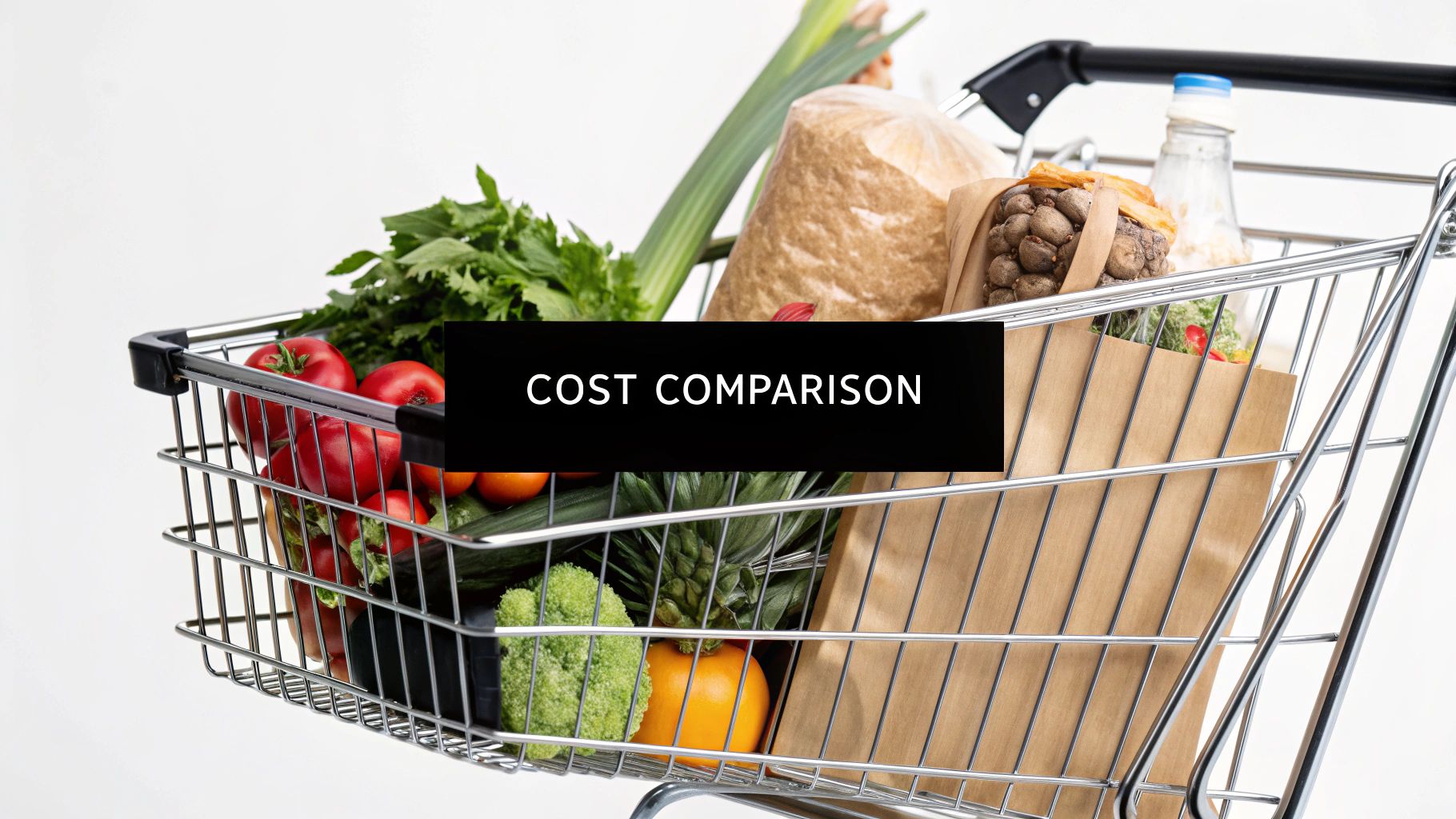
Let's be honest: the price tag is often where the organic vs. non-GMO debate gets real for most of us at the grocery store. Both labels represent a step away from conventional agriculture, but the reasons behind their costs are worlds apart. An organic sticker almost always means a higher price, and knowing where that extra money goes is crucial to deciding if it's worth it for you.
That organic price premium isn't just a marketing gimmick. It’s a direct reflection of the incredibly demanding, and expensive, agricultural standards required for certification. These farms are playing a different game, one that values long-term ecological balance over short-term, high-volume output. That approach simply costs more to pull off.
On the other hand, the Non-GMO Project Verified seal usually only adds a little to the final price. Since the certification focuses narrowly on avoiding GMOs, farmers can still use other conventional tools, like synthetic pesticides. This keeps their production costs—and the price you pay—much closer to standard items.
Why Organic Certification Costs More
The higher price of organic food comes down to a few specific, labor-intensive realities of the farming process. These aren’t one-off fees but constant, built-in operational expenses.
- Higher Labor Needs: Organic farmers can't just spray a field with herbicides. They rely on more hands-on, time-consuming methods like tilling, cover cropping, and even manual weeding to manage pests and weeds.
- Expensive Certification: Getting that USDA Organic seal is a serious investment. It involves meticulous record-keeping, annual on-site inspections, and fees that can be a real hurdle, especially for smaller family farms.
- Smaller Farm Yields: By design, organic farming practices often result in lower yields per acre. Without synthetic growth-promoters and with a focus on crop rotation for soil health, the output is naturally less than a conventional farm.
- Investment in Biodiversity: A healthy organic farm isn't just rows of crops. It includes buffer zones and cover crops to foster a balanced ecosystem, which requires land, time, and resources that don't produce a crop to sell.
The economic trade-off is pretty straightforward. Organic farming pours its investment into the process—building healthy soil, paying for more manual labor, and promoting biodiversity. This drives up the cost. Conventional farming, even the non-GMO variety, uses chemical inputs to boost efficiency and cut down on labor, which keeps the price lower.
To see how this plays out on the shelf, it helps to break down the specific factors influencing the final price of both organic and non-GMO products.
Cost Factors: Organic vs. Non-GMO Products
| Cost Factor | Impact on Organic Price | Impact on Non-GMO Price |
|---|---|---|
| Certification Fees | High; covers a comprehensive audit of the entire farm system, from soil to sale. | Moderate; primarily focused on testing and verifying the absence of GMOs in the final product. |
| Labor & Pest Control | High; relies on manual work, beneficial insects, and other labor-intensive methods. | Low; synthetic pesticides and herbicides are permitted, which are cheaper and more efficient. |
| Crop Yields | Often lower due to the absence of synthetic fertilizers and a focus on long-term soil health. | Typically higher, on par with conventional yields, keeping per-unit costs down. |
| Soil Management | High; requires significant investment in compost, manure, and cover crops to build fertility. | Low; relies on cost-effective, readily available synthetic fertilizers for nutrients. |
As you can see, when you buy organic, you're paying for more than just the food itself. You're funding a specific agricultural system that is fundamentally more expensive to operate. The non-GMO label, while addressing a very important consumer concern, doesn't carry the same weight of built-in operational costs, and its price reflects that.
Making Smart Choices for Your Priorities
Trying to decide between organic and non-GMO doesn't have to be an all-or-nothing game. The smartest way to shop is to figure out what matters most to you—your health goals, your family's needs, and your budget—and let that guide your decisions. You don't need to feel boxed in by one label.
Let’s break it down into a simple framework. If your number one priority is to cut down on your family's exposure to synthetic pesticides and herbicides, then the USDA Organic seal is your best bet. It's the only label that makes a clear promise on that front, making it the go-to for anyone focused on avoiding chemical residues.
On the other hand, what if your main concern is simply steering clear of genetically modified organisms, especially in common high-risk crops like corn, soy, and canola? In that case, the Non-GMO Project Verified label is a fantastic choice. It tackles the GMO issue head-on and is often a more wallet-friendly option since it doesn't involve all the other requirements of a full organic certification.
Prioritizing Your Organic Spending
Let's be realistic: for most of us, an all-organic grocery cart just isn't in the budget. This is where a little strategy goes a long way. You can get the most bang for your buck by focusing your organic spending on the produce that is known to have the highest pesticide levels.
A brilliant resource for this is the Environmental Working Group's annual "Dirty Dozen" and "Clean Fifteen" lists. These guides are incredibly helpful for pinpointing which fruits and veggies have the most (and least) pesticide residue.
- The Dirty Dozen: This is your priority list for buying organic. It typically includes things like strawberries, spinach, and kale—items that tend to hold onto pesticides.
- The Clean Fifteen: This list is your green light for saving some cash. It features produce with minimal pesticide residue, like avocados, sweet corn, and onions. You can feel pretty good about buying the conventional versions of these.
Thinking this way changes how you shop. You’re no longer just chasing a label; you’re strategically investing your money where it counts the most for your personal health.
Your Choices Shape the Market
Every time you choose a product with one of these labels, you're sending a message. You're part of a massive consumer movement pushing for a more transparent and natural food system, and it's working. In fact, organic food sales in the U.S. recently soared to $71.6 billion, growing at double the rate of the conventional food market. That’s a powerful testament to a real shift in what shoppers value. You can dive deeper into these organic market trends and see just how much consumer preferences are reshaping the food industry.
Ultimately, once you understand the real differences between organic and non-GMO, the anxiety melts away. You can confidently build a grocery cart that reflects a balanced, thoughtful approach: organic for the Dirty Dozen, non-GMO for products where that’s your main concern, and conventional for low-risk items. It’s about being an informed shopper who makes smart decisions that fit your life.
Answering Your Top Questions
Even when you think you have a handle on the labels, practical questions always pop up in the grocery aisle. The whole organic vs. non-GMO debate can get tricky, so let's walk through some of the most common dilemmas shoppers run into.
This is your quick-reference guide for real-world shopping. We’ll clear up the confusion and give you the confidence to make choices that actually fit your family's health goals and your budget.
Is Non-GMO the Same as Organic?
No, and if you remember one thing, make it this. This is the single most important distinction to understand.
Here’s the deal: all USDA-certified organic products are always non-GMO. The organic standards flat-out prohibit the use of genetically modified organisms. It's a non-negotiable part of the certification.
But—and this is a big but—a product with the Non-GMO Project Verified label is not necessarily organic. It could have been grown with conventional farming methods, which often means synthetic pesticides and chemical fertilizers. The non-GMO label focuses on that one specific attribute, while the organic seal looks at the entire farming system.
How Do I Know If Unlabeled Food Has GMOs?
In the United States, most food manufacturers now have to disclose "bioengineered" (BE) ingredients thanks to the National Bioengineered Food Disclosure Standard. You might see this show up on a package in a few different ways:
- A simple text disclosure like "Bioengineered" or "Contains a bioengineered food ingredient."
- The official black-and-white BE symbol.
- A QR code you can scan with your phone for more details.
While that's a step toward transparency, it's a passive system. If you want to be proactive about avoiding GMOs, your best bet is to look for the verification seals. Choosing products with either the USDA Organic seal or the Non-GMO Project Verified butterfly is the only way to be sure the product has met strict standards for GMO avoidance.
Are Organic Foods Healthier or More Nutritious?
This is a hot-button issue, and the science is still evolving. Some studies have suggested organic foods might have higher levels of certain antioxidants and micronutrients. On the other hand, different research has found no major nutritional differences. It's an ongoing conversation.
The primary, undisputed health benefit of going organic is drastically cutting your exposure to synthetic pesticide residues. Hundreds of chemicals are outright banned in organic farming.
So, the choice often boils down to what you want to avoid. If your main goal is to minimize your intake of synthetic chemicals and get a guarantee of non-GMO ingredients, organic is the clear winner. The focus is less on what's added nutritionally and more on what's been left out.
Why Is a Product Labeled Non-GMO If No GMO Version Exists?
Honestly, this is often just a clever marketing tactic. It's designed to catch the eye of health-conscious shoppers. You might spot a "Non-GMO" claim on a bag of wild-caught salmon, a container of salt, or a bottle of orange juice.
The catch? There are no genetically modified salmon, oranges, or salt on the market. Salt is a mineral; it can't be genetically modified in the first place. Seeing the label on these products can be pretty misleading.
The Non-GMO Project does a good job of curbing this by typically only verifying products that have a high-risk GMO counterpart. That's why it's so helpful to know which crops are most likely to be genetically modified. The main ones are:
- Corn (over 90% is GMO)
- Soybeans (over 90% is GMO)
- Canola
- Sugar Beets
- Cotton
Knowing this list helps you spot when a non-GMO label is giving you valuable info versus when it's just marketing noise. This context is key to navigating the organic vs. non-GMO landscape and making decisions you can feel good about.
At Naked Pantry, we simplify these choices for you. We believe that what's not on your food is just as important as what is, which is why we prioritize sourcing US-grown organic products whenever possible. And by delivering all our pantry staples in 100% plastic-free packaging, we ensure your food is free from harmful chemicals like BPAs and phthalates, too. Start building your plastic-free pantry today.
